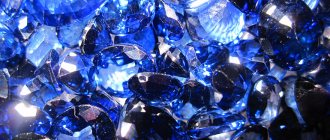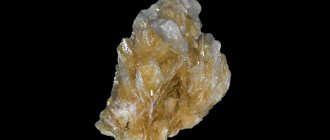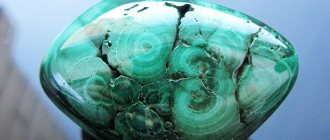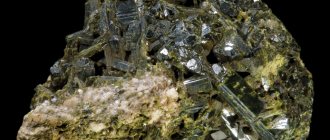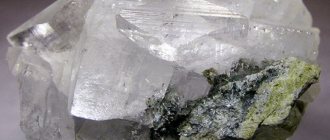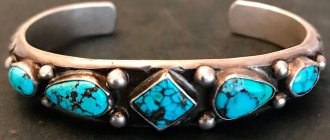The azurite stone, which gets its name from the French word azur, meaning “azur,” bears its name for a reason. This is the only way to call a sky-blue mineral endowed with a beautiful glassy sheen and amazingly smooth edges.
Azurite is a mineral endowed with a number of unique properties: first of all, the ability to boil in hydrochloric acid, and also the ability to transform into malachite (a very valuable bright green mineral).
Azurite stone - origin story
Over the centuries, azurite has changed its name more than once. In France, it is still called chessilite (in honor of the town of Chessy, in the vicinity of which these beautiful gems were mined for a long time).
The stone received its current name in 1824 thanks to the French mineralogist Francois Beudan. The mineral has many synonymous names that have survived to this day.
It is known to some as “copper blue,” “mountain blue,” “copper blue,” or “copper lapis.”
Since ancient times, azurite has been used by Irish shamans and Egyptian priests as a material used to make magical amulets and religious objects.
European painters, who created their canvases in the 15th-17th centuries, widely used bright blue paint made from azurite, ground into powder. The ceiling of the Sistine Chapel is painted with the same paint.
Azurite and lapis lazuli: differences between minerals
Among Aristotle's works there are notes on stones. The ancient Greek philosopher described many minerals, examining in detail their physical characteristics and properties.
There was also copper glaze among them. The Thinker combined two separate minerals - azurite and lapis lazuli - into one. This led to the fact that different minerals with similar names began to be confused.
How to distinguish them:
- Mountain blue has a darker, richer hue, while lapis lazuli has a brighter color.
- Lapis lazuli also comes with impurities. These are usually gold inclusions of pyrite. If you cannot distinguish which of the two minerals is in front of you, pay attention to the shade of the admixture of other minerals.
When you cannot visually recognize a pebble, and there is no opportunity to visit a specialist, try using a radical method of checking:
Make a scratch on the surface using a coin or knife. These actions will not harm lapis lazuli, because it is more durable. But on its brother there will be traces of metal.
It is, of course, better not to resort to this method of verification if the jewelry is valuable to you.
Physical properties
Azurite, striking in its variety of rich shades of sky blue, is a natural mineral, a subtype of copper ore. Its crystals have smooth edges and a characteristic glassy luster.
Deposits of this mineral are concentrated in places where copper and polymetallic ores occur, the oxidation of which leads to the formation of columnar crystals of azurite, which can be transformed over time into precious malachite.
- The chemical composition of azurite, as can be seen from its chemical formula – Cu3(CO3)2(OH)2 – includes copper carbonate and hydroxide anions.
- The rich blue color of the mineral is due to its high (at least 55%) copper content.
- The mineral is quite fragile. Its hardness range on the Mohs scale is 3.5-4 units, and its density is 3.8 g/cm3.
- Azurite has a conchoidal fracture and perfect cleavage.
Azurite Information
— Advertising —
Azurite is a type of copper ore, in nature it is not as common as lapis lazuli, but is cheaper in cost. Deposits of this mineral are characterized by a high level of copper sulfites, which oxidize to form crystals. Azurite nuggets of cryptocrystalline form. They often form combinations with malachite called azure-malachite.
Place of Birth
The richest azurite deposits are located in:
- USA;
- Chile;
- Mexico;
- Australia;
- Germany;
- France;
- Kazakhstan.
The largest and highest quality azurites are mined in small deposits of South and North Africa, located in:
- Namibia;
- Morocco;
- Zambia;
- Zaire.
In Russia, the supplier of unusual types of azurite is the Gumeshevsky copper mine, located in the Southern Urals.
Compatibility with other stones
“Mountain blue”, receptive to the feminine energy “yin”, belongs to the element of Water. The successful compatibility of this mineral with stones - representatives of the water element, such as:
- emerald;
- euclase;
- chrysoberyl;
- heliotrope;
- opal;
- olivine-peridot;
- Moonstone;
- goshenite;
- aquamarine;
- alexandrite;
- topaz;
- hematite;
- pearl;
- coral.
In addition, a combination of azurite with representatives of the Earth element is acceptable. These include:
- chalcedony;
- morion;
- nephritis;
- zircon;
- agate;
- charoite;
- lapis lazuli;
- hematite;
- malachite;
- coral;
- turquoise;
- amber;
- onyx;
- rauchtopaz;
- heliotrope;
- jet;
- jade;
- jasper;
- sarder;
- aventurine;
- serpentine;
- rhodochrosite;
- crocodile;
- melanitis.
Azurite is completely incompatible with minerals that belong to the elements of Air and Fire. In combination with representatives of these elements, “mountain azure” loses its magical properties.
Varieties, colors
Azurmalachite
In its pure form, azurite is extremely rare, because, attracting other rocks lying nearby, it grows together with them, forming unusually beautiful crystals, striking in a variety of shades and colors: from dark blue and bright blue to rich purple and almost black.
Depending on what rocks the azurite crystals are fused with, they are distinguished:
- azurmalachite is a mineral formed by the fusion of azurite and malachite;
- burnite - a rock formed as a result of the fusion of azurmalachite with cuprite;
- blue copper is a mineral obtained by merging crystals of pure azurite and chrysocolla.
History and origin
Azurite only got its own name in 1824. Before this, the mineral could not be distinguished from lapis lazuli, which was similar in characteristics. Even in the works of Aristotle there are references to both stones, between which, due to the weak development of science, there was no difference.
In Arabic, azul means blue. In modern terms, this word sounds like azure, which gives the name lapis lazuli. The mineral azurite, practically indistinguishable from it, was named almost identically, retaining the same Arabic root.
In the Middle Ages, both were used to make a blue dye called “stuffed cabbage,” and processing azurite took much less time and effort compared to lapis lazuli.
The paint was a deep blue shade and was used by artists in painting. The most famous masters painted their masterpieces with this paint; for example, natural cabbage roll was used when painting the Sistine Chapel.
Interesting! Under the influence of the sun, azurite changes its color to green and turns into malachite.
Because of this, several centuries later, in the paintings of that time, it is not the blue tint that predominates, but the malachite tint. Currently, azurite has become more widespread: jewelry, crafts, and gunpowder for green pyrotechnic shells are made from it. Paint with natural pigment is now produced only for icon painting.
View this post on Instagram
Publication from AUTHOR'S JEWELRY TALISMANS (@natali.jewelry.natali) Jun 2, 2021 at 3:12 PDT
How is it different from lapis lazuli?
People who do not understand mineralogy often confuse azurite with other rich blue minerals, most often with lapis lazuli.
These outwardly similar stones can be distinguished by a number of characteristics:
- The color of azurite is more rich and deep. The bright color of lapis lazuli is emphasized by golden inclusions of pyrite, sparkling in the sunlight.
- Lapis lazuli is a harder stone. A copper coin will not leave a scratch on its surface, while azurite can be easily scratched by both a coin and a knife.
- On the rough surface of a white porcelain plate, when worn away, lapis lazuli leaves a bright blue line, while azurite leaves a sky-blue line.
Caring for stone products
A fragile and finicky stone requires special care. Otherwise, it will lose its original beauty and color. To preserve the aesthetic properties of azurite, you should:
- protect the mineral from mechanical damage (scratches, falls or impacts);
- Avoid contact with water or high humidity;
- regularly clean the surface with a dry cloth without using detergents or detergents;
- store in a cool place, trying to avoid close contact with other decorations and direct sunlight.
Such affordable care measures for products made from eye-catching stone will allow you to preserve for a long time the pristine beauty and originality, valued by collectors and ordinary admirers of beauty.
Magic properties
In terms of energy, azurite is an example of the manifestation of feminine Yin energy. Having faced the influence of negative energy and passing it through itself, the gem makes this energy positive.
The magical properties of azurite were already known to the priests of Ancient Egypt, who used it as an intermediary during sessions of communication with the gods.
Azurmalachite, which combines the energy of two minerals at once, is endowed with double strength. Malachite, which is part of its composition, frees the human body from negative emotions, while azurite normalizes energy flows, reflecting the impact of negative energy.
During meditation, placing azurite on the crown chakra, one gets rid of adversity and anxiety, which are the culprits of strong internal experiences, ultimately finding complete harmony with both the inner and outer world.
A person who is faced with a difficult choice of a further path and does not know which direction to go can put on jewelry with azurite and wait for a hint.
The stone will certainly show you the right path to help you either avoid serious problems or solve them in the most optimal way.
Mediums and psychics highly value azurite balls, which help them in conducting meditations and spiritualistic sessions, during which the gem plays the role of an intermediary between the consciousness of its owner and his subconscious.
The rich blue color of azurite crystals stimulates the crown chakra (the so-called “third eye”), which promotes the development of logical, conceptual and tactical thinking, therefore the impact of jewelry made from this stone is beneficial for lawyers, judges and lawyers.
If the owner of azurite behaves immorally, allowing himself to commit bad deeds, the stone stops giving him its positive energy and may close, and in some cases even split.
Types of stone
One of the features of natural azurite is that it attracts nearby rocks, growing to them. As a result, the following varieties are obtained:
- blue copper – azurite plus chrysocolla;
- azurmalachite - azurite plus malachite, the most common option;
- burnite – azurmalachite plus cuprite, a rare species.
Their color palette ranges from bright blue to dark purple. Pure azurite is rare in the rock.
Medicinal properties
Since the energy of azurite is quite strong, lithotherapists do not recommend wearing it continuously for a whole month. After wearing it for three days, the jewelry with the stone should be removed and take a two-week break.
The healing properties of azurite allow it to be used for:
- Improving the composition of the blood and cleansing it of impurities.
- Reducing blood pressure.
- Relieving emotional stress.
- Accelerating the healing process of broken bones and soft tissue healing.
- Treatment of hysteria and epilepsy.
- Therapy of bronchial asthma.
- Treatment of skin diseases (including psoriasis and eczema).
- Improving vision and correcting some eye pathologies.
- Relieving pain accompanying arthritis and joint diseases.
- Treatment of diseases of the gastrointestinal tract, spleen, liver, bladder.
- Improvement of the endocrine system.
- Eliminate dizziness, relieve headaches, treat migraines.
- Normalization of the state of the nervous system, as a result of which the patient’s insomnia disappears, the feeling of causeless anxiety, depression and depression disappears.
The essence of the therapeutic sessions is extremely simple: during the procedure, pieces of the mineral are applied to the problem area of the body and left for several minutes. To enhance the therapeutic effect, lithotherapists recommend using azurite twice a day for meditation.
Who is Azurite suitable for?
It is believed that azurite and azurmalachite enhance the spiritual power of its owner, raise the level of his consciousness and bring him closer to subtle energies and cosmic forces. Lithotherapists believe that the stone helps open the “third eye”, possessing healing energy. It is believed that this mineral normalizes the movement of energy flows and eliminates blockages. It helps to bring thoughts into the field of consciousness and gain control over them.
Hindus claim that this stone mainly affects the first and fifth chakras (Ajna and Vishuddha). There is evidence that azurmalachite also has a positive effect on the Sahasrara.
- Helps a person become more aware.
- Allows you to interact with various energy entities.
- It is used in many magical rituals and ceremonies to enhance contact.
- Helps expand the boundaries of understanding.
It is recommended by shamans for those who have a creative profession, as well as for those whose profession is related to honesty and the establishment of justice. The mineral helps journalists, lawyers and judges make the right decisions.
In Ireland, azurite was used by Druids for hypnosis to experience certain feelings and states. This visualization ritual allowed young men to test their strength and courage. The young men realized that they were warriors and decided whether they could cope with the responsibilities assigned to them.
Who is suitable according to their zodiac sign?
- As a talisman, azurite (regardless of color) is ideal for representatives of the zodiac constellations Aquarius and Libra . The gem will help them develop intuition and learn to recognize lies, and will also give them the ability to make the right decisions even in very difficult situations. People born under the sign of Libra can feel the influence of a talisman even at a considerable distance from the house in which it is located, so they do not necessarily have it with them. Communication with the stone will make Aquarius wise, honest and spiritually balanced.
- Azurite will serve as an excellent amulet for Virgo , Taurus, Pisces and Sagittarius . His crystals will keep them from committing unseemly acts and will guide them on the right path. With its help, Pisces will become more patient, gain faith and hope. The gem will give Sagittarius self-control and self-confidence.
- For people whose zodiac sign is Gemini, the use of azurite as a talisman is strictly contraindicated, although it will bring them a lot of benefits for therapeutic purposes.
Azurite and the zodiac signs
In astrology, azurite is considered a symbol of such zodiac signs as Aquarius and Libra. Moreover, the stone itself is identified with the energy of Water and is under the patronage of Jupiter.
He has good compatibility with most signs, among which Libra and Aquarius can be singled out. But, oddly enough, it does not suit Gemini - perhaps Azurite “considers” them to be too superficial people.
| Zodiac sign | Compatibility (“+++” – fits perfectly, “+” – can be worn, “-” – strictly contraindicated) |
| Aries | + |
| Taurus | + |
| Twins | — |
| Cancer | + |
| a lion | + |
| Virgo | + |
| Scales | +++ |
| Scorpion | + |
| Sagittarius | + |
| Capricorn | + |
| Aquarius | +++ |
| Fish | + |
Talismans and amulets
Azurite belongs to the category of stones that play the role of guardians of all kinds of desires, prejudices, doubts and fears:
- Constantly wearing a talisman with azurite will provide its owner with high spirits and facilitate communication with others, so you should definitely take it to a job interview, business negotiations, or meeting with an important client.
- Azurite is an excellent amulet for those who want to change their lives for the better.
- A student can take an amulet with azurite, which helps to reveal intelligence, with him to the exam, and a student can keep it with him during the exam.
- For wise, honest and decent people, azurite will become a reliable assistant for many years, giving them peace of mind, self-confidence and ineradicable optimism. At the same time, for unkind, ambitious and deceitful people who have unclean thoughts and bad intentions, the stone will create obstacles on the way to their goal.
- A talisman with azurite will help you overcome anxiety and fear, avoid disagreements and conflicts, and find a compromise solution to any problem.
Jewelry with azurite, which plays the role of a talisman, should be worn as often as possible, since the stone needs constant contact with its owner. If stored in a box for too long, the magical properties of azurite are significantly reduced.
It is best to wear amulets and talismans with azurite:
- on the wrist;
- on the neck;
- in a pocket located at heart level;
- just squeezing it in your hand.
A copper frame will help them reveal their strength to the maximum extent. It is advisable to buy jewelry with azurite on Friday or Thursday. These same days are the most successful for wearing this stone on the body.
Healing properties
Jewelry azurite has a number of medicinal properties, highly valued in the past and used by modern lithotherapists. Among them the following can be noted:
- accelerates the process of resorption of bruises and hematomas;
- relieves pain, including headaches and cramps;
- eliminates scabies, helps cope with itching of the skin, including allergic etiology;
- normalizes blood pressure in hypertensive and hypotensive patients;
- restores disrupted hormonal levels, including alleviating the condition caused by raging hormones during the premenstrual period;
- helps improve well-being in arthritis, scoliosis and other joint diseases, anesthetizing problem areas and calming the nervous system;
- improves vision in both myopia and farsightedness;
- relieves bad mood and melancholy, has a beneficial effect on the general mental state, is indicated for stress, depression, and increased irritability.
Also read: Jadeite - an ancient source of luck and inspiration
Treatment of various diseases and disorders occurs as follows. The stone is applied to the main source of pain, and you need to communicate with it, mentally asking to get rid of the problem.
The ceremony is held twice a day - before going to bed and immediately after waking up. You can carry the talisman with you throughout the day (on your neck, on your wrist or in a pocket located near your heart).
It must be remembered that lithotherapy is not the main method of treatment, and one cannot expect that azurite will completely relieve a child from scoliosis or an adult from migraine. In severe cases, it is necessary to consult a doctor rather than self-medicate. A unique mineral will become a faithful assistant, accelerating the healing process.
Decorations
The rich dark blue color of the crystals, which have a spectacular greenish, grayish or brownish background, made azurite particularly attractive in the eyes of jewelers.
In processed form, they are used to make pendants, cufflinks, beads and earrings; however, despite their low cost, products with azurite inserts are quite rare on the jewelry market.
This is explained by the increased fragility of stones, which crack even with minor mechanical stress. Recently, elegant jewelry with small untreated stones covered with the finest silver mesh has come into fashion.
Applications for azurite
In the Middle Ages, azurite was used to create blue paints. Its processing was easier than for lapis lazuli. However, when exposed to air for a long time and when exposed to moisture, azurite turns into green malachite, which explains the abundance of green tint in the paintings of old masters.
In jewelry, azurite is used as an inexpensive ornamental stone, but its use is limited due to its fragility, low strength and relative color instability. For these purposes, the more convenient and durable azure-malachite is much more often used. Azurite is more popular as a collector's item.
The mineral has also been used in pyrotechnics to produce green flames. As a component of copper ores, the mineral is used in copper smelting and to obtain vitriol.
Other uses of stone
- In the Middle Ages and the Renaissance, azurite was used to obtain a natural pigment that was used to prepare blue paint, which was used for painting church vaults, painting canvases and icons.
- Nowadays, azurite, which is an inexpensive ornamental stone, is used to make original souvenirs and crafts.
- In industry, azurite, which is a minor component of complex copper ores, is used in the process of obtaining copper sulfate and copper smelting.
- In pyrotechnics, azurite is the main component of chemical compositions that give fireworks and fireworks a bright green color.
- Azurite cabochons, which are notable for their low cost (from 3 to 7 dollars per gram), often become almost the first items in the collections of mineral lovers.
How is azurite stone used?
Mountain blue has a rich, very interesting history, which many fashionistas are not even aware of, believing that the scope of the mineral is limited to jewelry.
During the Middle Ages, azurite was very popular among creative people. Artists used it in painting - crushing it into dust to use as a natural dye. The ancient Greeks and Romans resorted to blue pigment. And under the name “cabbage roll” it was known in the circles of ancient Russian painters.
The stone has found its application in industry and even in pyrotechnics. Here it is used to obtain copper sulfate. This artificially derived substance works very well as an antiseptic when cleaning the house from mold, and also helps plants fight diseases and pests. Returning to fireworks, it is azurite that is responsible for the green-blue tones of decorative lights.
Well, there’s nothing to say about decorations. Rings, earrings and necklaces with such a stone look stylish. They are equally suitable for both evening and business attire - the owner of such jewelry can be confident in its irresistibility.
Price and care
The cost of azurite is quite affordable:
- A polished round pebble with a diameter of 0.8 cm will cost the buyer 500-700 rubles.
- For a stone having the shape of a rectangle or square and an area equal to 1 cm2, you will have to pay 600-800 rubles.
- Processed azurite of irregular shape, having an area of 3-5 cm2, will cost 900-1200 rubles.
The cost of a stone depends not only on its size (the larger, the more expensive), but also on the place of extraction, the method of jewelry processing and on the type of inclusions its crystals contain.
Azurite is able to retain its unique properties and pristine beauty of color only if properly stored and cared for:
- Azurite should be stored in a cool, dry room, not subject to sudden temperature changes and away from direct sunlight. If exposed to high humidity for a long time, this mineral may turn green.
- Being an extremely fragile mineral, azurite needs protection from mechanical stress (strong impacts and falls from a height).
- To avoid scratching products with azurite, they should be stored either in a separate, tightly closed box or in a special bag made of soft material.
- Jewelry containing azurite should be cleaned with a piece of soft, dry cloth. Heavily soiled items can be washed with warm soapy water, remembering to wipe dry. However, contact with very hot water can cause the stone to lose its beautiful shine. The mineral should also be protected from exposure to household cleaning products.
Price
The cost of azurite in cabochons is $3–7 per gram , depending on the degree of transparency and size (the larger the stone, the higher its value). Samples from the Congo are the highest quality.
Examples of prices for the mineral and jewelry with it:
- bead (crumbs, 5–10 mm, 10 g) — 94 rub. ;
- azurite (5 x 3.5 cm) - RUB 1,336. ;
- pendant - 4,300 rub. ;
- ring (silver) - 4,800 rub.
How to distinguish from a fake?
In order to distinguish natural azurite from a skillful fake, you can:
- Place the stone in a container of clean water for several hours. Contact with natural stone will not change the color of the water. Interacting with a fake will turn it blue.
- Break off a tiny piece from the sample and place it in a flask with hydrochloric acid. The natural mineral will definitely “boil.”
In addition, a genuine stone must:
- be completely transparent;
- have a number of ordered elements in its structure (such as streaks, stripes or rings);
- have a golden sheen rather than transparent.
Jewelry with mineral
Despite its stunning beauty and brightness, azurite is rarely used in the jewelry industry. This is due to the fragility of the mineral, which is damaged even with light impact, as well as color instability.
But in stores you can still buy spectacular beads, earrings, pendants and cufflinks with blue stones. They are especially popular among the fair sex due to their versatility - they look equally good on both delicate blondes and sizzling brunettes or luxurious brown-haired women.
The price of the mineral in cabochons is minimal and amounts to $3-7 per gram. The larger the mineral, the higher its gemological value. The cost of jewelry depends on the metal in which the stones are framed. So, a silver ring with azurite costs from 1,500 to 3,000 rubles.
Crystals and cabochons are of great value to collectors, who often begin collecting minerals after becoming acquainted with azurites that play in all shades of blue. Decorative elements are often made with azure-colored stone that can decorate any interior.
But in this case, it is important to follow some safety measures to preserve the natural stone in its original form - keep it in a dry room away from direct sunlight.
What stones does it go with?
Bracelet with azurite and hematite
It has been established that the powerful energy of azurite combines well with the energy of:
- Hematite. This combination of stones helps improve memory and unlock intellectual potential, so jewelry with them can become successful mascots for schoolchildren and students.
- Lapis lazuli, tourmaline, blue topaz. In combination with these minerals, azurite will help maintain clarity of thinking, show uncompromisingness and objectivity. Products with these stones can be worn by representatives of professions that require honesty and impartiality: judges, critics, journalists.
- Yellow topaz and citrine. Jewelry with these minerals will help a couple in love maintain the ardor of their feelings.
Where is the gem used?
The physical and aesthetic characteristics of azurite have led to its demand in several areas.
Arts and crafts
Inexpensive ornamental stone is loved by stone cutters. Its surface allows you to create exclusive works every time.
Collections
Azurite is a mineral valued for its rich colors, intricate patterns, and original combinations with other neighboring minerals in the deposit. Private collectors hunt for the stone; azurite ore is a coveted exhibit at state or corporate gemological collections.
Painting
The properties of the mineral have been well studied by artists, especially icon painters, who cannot do without sky-blue tempera from azurite or green paint from azure-malachite. The tradition dates back to the times of Andrei Rublev with the famous “Trinity”, Raphael and Michelangelo.
Jewelry
Fragility, color instability, and difficulty in processing limit the use of azurite in jewelry.
To maintain its integrity, the treated pebble is framed with an elegant silver mesh. Jewelry is becoming more refined, but there are few of them and they are almost always small beads or inserts for cufflinks. Sometimes they are coated with wax or another transparent substance.
Less hassle with durable azurmalachite, which is easier to process. Jewelry is also expensive due to its unusual color. And expertly cut stones sparkle no worse than a diamond.
Pyrotechnics
Azurite is included in the mixture used for green fireworks.
Industry
Low quality specimens are used to make copper sulfate and as a component in copper smelting.
The BMW concern created “black azurite” for autoflowering.
Talismans and amulets
Azurite is, first and foremost, a protective crystal. It will help you live positively and communicate easily. He is taken to important events - business meetings, interviews, castings.
This is a talisman for people who intend to change their lives for the better and attract good luck.
The power of the stone helps to absorb knowledge, so it is suitable for anyone who studies, especially during exams.
When a romantic relationship begins, the gem will help bring it to its logical conclusion.
A figurine or azurite crystal on the windshield of a car will be useful for the driver to maintain composure on the road and philosophically endure traffic jams.
Among those for whom the stone is suitable as a professional talisman are journalists, lawyers, and judges. That is, called upon to defend justice.
Interesting Facts
- The pigment, made from natural azurite, was used by Russian icon painter Ivan Rublev to create the Trinity icon.
- The most beautiful azurites, with extraordinary transparency and large sizes - up to 30 cm - are mined in the deposits of Namibia. The largest azurite found here in 1979 weighed 26 kg.
- A truly gigantic block of azurite, weighing 4.5 tons, was discovered in the Copper Queen mine (Arizona, USA). You can see this miracle of nature, called the “singing stone,” at the Natural History Museum located in New York.
- The supplier of fairly large (about 6 cm in diameter) minerals in Russia is the Ural mine “Gumeshki”.
Application
Azurite has found its application in many areas of life. Unusual crafts and souvenirs are made from the mineral. It is not so common in jewelry due to its increased fragility, but craftsmen have found a way to preserve the integrity of the stone in jewelry. Thus, exquisite jewelry appeared on sale in which azurite is covered with a thin silver mesh.
Since ancient times, the pigment of the stone was used in the preparation of blue paint, which was used to paint pictures and icons. Collectible masterpieces of past centuries can still be found today.
Azurite is also used in the industrial sector. With its help, copper sulfate is obtained and copper is melted. In pyrotechnics, the mineral is used as the main component of green fireworks and salutes.
Azurite is revered by gemologists and collectors due to its unique, rich color and crystal structure.
Classification (varieties, colors, types)
The color range of azurite is very diverse. It can be cornflower blue, blue, azure blue, dark blue, dark blue, purple. You can find transparent and black specimens. Due to such diversity in color, azurite is often confused with the following blue stones: lapis lazuli, sadolite, gayunite. But basically it is identified with lapis lazuli.
Lapis lazuli and azurite are blue stones, but if you look closely at each, you can see that azurite is a more saturated color, and the color of lapis lazuli is brighter, interspersed with perite.
The shade has a direct relationship with the deposits, the chemical composition of the deposits, with the characteristics of the stone, which can attract ore and various minerals. Therefore, there are several types of it:
- azuromalachite (a mixture of azurite and malachite);
- blue copper (a mixture of chrysocolla and azurite);
- brunite (a combination of cuprite and azuromalachite).
In nature, it is practically impossible to find azurite in its pure form, without impurities. As a rule, native copper, calcite and some other “companions” are adjacent to this mineral.
Chemical composition of the stone
The chemical composition of azurite is: copper oxide, carbon dioxide, water. It is a basic copper carbonate mineral whose chemical formula is 2Cu [CO3] x Cu [OH]2. (code 55.2 Cu).
Physical properties
Azurite belongs to the mineral category, a class of carbonates that includes copper ore. Under certain conditions and over time, blue azurite turns into a valuable, from the point of view of jewelers, malachite stone. Azurite has a cryptocrystalline structural form, a conchoidal fracture, is quite fragile, and the edges have a mirror shine.
As for the syngony, it is monoclinic.
Its hardness on the Mohs mineralogical scale is 4, density is 3.5 - 4 g/cm3, specific gravity ranges from 3.77 to 3.89 g/cm3.
Quite often you can find azurite in druses of small crystals, solid granular masses, and rarely in aggregates of the radial type. Often in nature you can find very beautiful multifaceted azurites, which form small druses, long prismatic appearance, short and thick tabular crystals. As for the jewelry sphere, it is very limited due to the low strength of the stone. Basically, the areas of application of azurite are as follows: it is used for crafts and decorative purposes, as well as in industry and pyrotechnics.
Azurite deposit and mining
Where is azurite mined? The deposits of these minerals are considered to be areas where copper is located. The main mining areas are Mexico, New Mexico and Arizona (USA), Chile, Queensland (Australia), Germany, France, Zaire and Zambia (Africa), Kazakhstan, Touissite and Mibladen (Morocco). Azurite deposits in the vast expanses of Russia are located mainly in Altai and the Urals, where adularia is mined.
The most beautiful and transparent gems, the size of which reaches 30 centimeters, are found in Namibia. It was there that the largest mineral was mined in 1979, weighing 26 kg.



